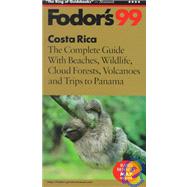
| About Our Writers Each year the Gold Guides are written and updated by more than 500 resident writers | |
| Connections Resources for travelers | |
| How to Use This Book Describes organization, icons, and other key information | |
| Please Write to Us Tells you how to get in touch with our editors | |
| The Gold Guide: Smart Travel Tips A to Z An easy-to-use section divided alphabetically by topic | |
| Under each listing you'll find tips and information that will help you accomplish what you need to in Costa Rica | |
| You'll also find addresses and telephone numbers of organizations and companies that offer destination-related services and detailed information and publications | |
| Destination: Costa Rica Helps get you in the mood for your trip | |
| New and Noteworthy Cues you in on trends and happenings | |
| What's Where Gets you oriented | |
| Pleasures and Pastimes Describes the activities and sights that make Costa Rica unique | |
| Fodor's Choice Showcases our top picks from special restaurants and one-of-a-kind accommodations to out-of-the-ordinary sights and activities... | |
| Let them inspire you! San José All you need to know about the vibrant capital, including sections on exploring San José, dining, lodging, nightlife and the arts, outdoor activities and sports, and shopping, and a practicalities section called San Jose A to Z | |
| Central Valley: Around San José Including the western Central Valley, eastern Central Valley, Orosi Valley, Turrialba and the Guayabo National Monument, and the Central Valley: Around San José A to Z | |
| Northern Guanacaste and Alajuela With Arenal and the Cordillera de Tilarán, Far Northern Guanacaste | |
| Nicoya Peninsula With the best from Puntarenas to Cabo Blanco, Nicoya and the Tempisque River Delta Region, Central Nicoya beaches, Liberia and Northern Nicoya Beaches, and Nicoya Peninsula A to Z | |
| Central Pacific Costa Rica With the Central Pacific Hinterlands, the coast near San José, and Central Pacific Costa Rica A to Z | |
| Southern Pacific Costa Rica With General Valley, Osa Peninsula, and Southern Pacific Costa Rica A to Z | |
| The Atlantic Lowlands and the Caribbean Coast With Braulio Carrillo National Park and the Northern Lowlands, Tortuguero and Barra del Colorado, coastal Talamanca, the Atlantic Lowlands, and the Caribbean Coast A to Z | |
| Excursions to Panama With Chiriquí Province, and the Bocas del Toro Archipelago | |
| National Parks and Biological Reserves With the Central Valley: Around San José, Northern Guanacaste and Alajuela, Nicoya Peninsula, Central Pacific Costa Rica, Southern Pacific Costa Rica, the Atlantic Lowlands and the Caribbean Coast, and Panama | |
| Portrait of Costa Rica A wonderful essay about the biodiversity of Costa Rica | |
| Index List of Maps | |
| Table of Contents provided by Publisher. All Rights Reserved. |
The New copy of this book will include any supplemental materials advertised. Please check the title of the book to determine if it should include any access cards, study guides, lab manuals, CDs, etc.
The Used, Rental and eBook copies of this book are not guaranteed to include any supplemental materials. Typically, only the book itself is included. This is true even if the title states it includes any access cards, study guides, lab manuals, CDs, etc.
Excerpted from Costa Rica, '99: The Complete Guide with Beaches, Wildlife, Cloud Forests, Volcanoes and Trips to Panama by Fodor's Travel Publications, Inc. Staff
All rights reserved by the original copyright owners. Excerpts are provided for display purposes only and may not be reproduced, reprinted or distributed without the written permission of the publisher.